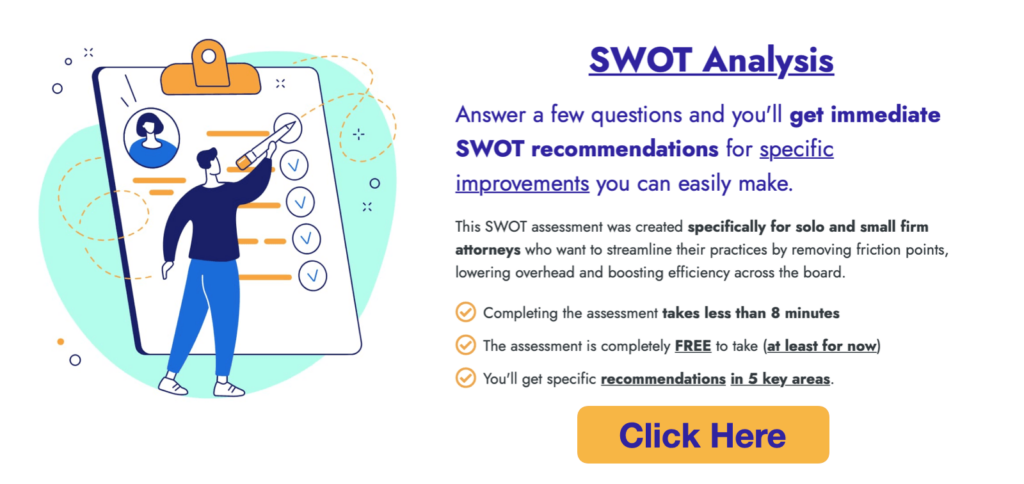A SWOT analysis can be very helpful to your law firm and your law practice. So what is this exactly?
SWOT is an acronym for the four elements of a well-regarded business analytic process. Here are the four elements:
- Strengths: things that give your business an advantage.
- Weaknesses: things that put your business at a disadvantage.
- Opportunities: things that your business can exploit to its advantage.
- Threats: things that could cause trouble for your business.
By conducting a thorough analysis, you can identify areas where your firm is excelling and areas where it could use improvement.
This guide will provide you with step-by-step instructions on how to conduct a SWOT analysis for your law firm.
Why do a SWOT analysis?
A SWOT analysis for lawyers is a strategic planning tool that can drive success in your business. SWOT analysis will help you make informed decisions about your firm by identifying areas for improvement and growth.
Use SWOT to identify your law firm’s strengths
The first step in conducting a SWOT analysis for your law firm is to identify your strengths. These are the internal factors that give your firm a competitive advantage over others in the industry.
Some examples of strengths for a law firm could include
- strong reputation in the community
- a team of experienced attorneys, or
- a specialized practice area
- being too concerned with useless criticism.
Take some time to brainstorm and make a list of all the things that your firm does well. This will help you build a foundation for the rest of your analysis.
SWOT analysis can identify your firm’s weaknesses
After identifying your law firm’s strengths, it’s important to also analyze your weaknesses. These are the internal factors that put your firm at a disadvantage compared to others in the industry.
Some examples of weaknesses for a law firm could include:
- inadequate staff or outsourced support
- ineffective use of technology (e.g. automation or A.I.)
- ineffective marketing (especially digital, online tactics)
It’s important to be honest and thorough when identifying weaknesses, as this will help you develop strategies to address them and improve your overall performance.
Use SWOT to identify opportunities for growth
Once you have analyzed your law firm’s strengths and weaknesses, it’s time to look for opportunities for growth. These external factors could positively impact your firm’s performance, such as changes in the legal industry, emerging technologies, or new markets you could target.
Conducting market research and staying up-to-date on industry trends can help you identify these opportunities. Once you have identified them, develop strategies to take advantage of them and position your firm for success.
SWOT analysis will identify potential threats
In addition to identifying opportunities for growth, it’s important to analyze potential threats to your law firm. These external factors could negatively impact your firm’s performance, such as regulation changes, economic downturns, or increased competition.
By identifying these threats, you can develop strategies to mitigate their impact and protect your firm’s success.
SWOT analysis is useful for law firms
SWOT analysis for lawyers is incredibly useful. If you’re starting a new law firm, you should definitely do a SWOT analysis.
Even after doing a SWOT analysis for your law practice, it’s important to regularly revisit it to stay ahead of potential threats and capitalize on opportunities.
Take this SWOT Analysis for Lawyers
If you’re willing to take a few minutes and answer a few questions, you can get an immediate analysis of the best opportunities for improving your law practice.
Use technology to radically improve your law practice by focusing on the few core elements that have the biggest impact.







